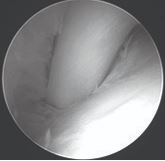
Loose fragments of bone and cartilage:
Osteochondrosis / Osteochondritis Dissecans (OCD) of the knee, shoulder, elbow
Inflammation: Synovitis (inflamed joint lining)
Injuries and hereditary conditions in specific joints: Shoulder - OCD, inflammation or tears of the bicipital tendon, shoulder instability Elbow - OCD, Ununited Anconeal Process (UAP) and Fragmented Coronoid Process (FCP) associated with elbow dysplasia Knee - cranial cruciate ligament tears with instability, meniscal tears
Tarsus (Hock Joint) OCD
Superior visualization due to arthroscopic access and magnification
Significantly lower pain levels
Earlier and better post-operative use of the limb
